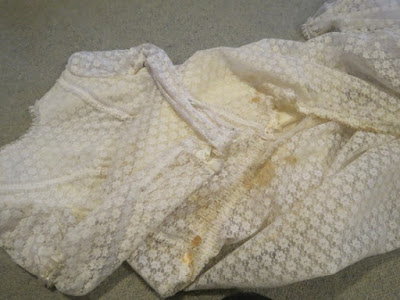The marks were a lot worse than have shown in the photo, with dark stains across the base of the bodice as well. But around the hem and train were the worst affected areas.
I would like to know what these mysterious marks are that appear on old clothing. Rust coloured, but not rust. Garments frequently look as though they have been used to wipe down a rusty fence. I can find a lot of information on the internet on how to remove these stains, but no explanation of how they get there in the first place. I guess it must be a chemical reaction between something in the garment and something in the air or environment over time.
Solution no.1 - Laundry soaker. I use Napi-San Oxy Action for whites. There is another formula for coloureds. And while I can hear vintage clothing sellers out there going "tut, tut", about treating old garments this way, what have I got to lose? Nobody would want to wear it in this state. You'll be glad to know that if I'm ever lucky enough to find a 1920s silk sequined dress I won't be soaking it. Many hard core vintage sellers say you mustn't wash vintage garments at all, and while I agree that's true for the flapper dress, lots of other garments are worth the risk of a soak and wash to make them more wearable. I don't like that musty old smell either. Most things are better for a freshening up. I have only had one or two minor tragedies so far.
So, into the bath she went.
Some of you may have read an earlier post where I also washed my daughter's wedding gown in the bath tub "Here she goes again," I hear you say. Never fear, Evie's gown went into the gentle wool washing detergent, not the soaker.
I call this dress the Juliet gown. I called it this the day I bought it, because it reminds me of the dresses worn by Olivia Hussey in Zeffirelli's 1968 version of the play. These dresses had the Empire line and puff top fitted sleeves popular both in Renaissance times and in 1968!
So, the dress came out of the bath a lot whiter than it went in. However, there were still a number of marks around the hem, particularly on the train. Next idea?
Solution No.2 - The Great Australian Summer.
The dress hung about my office for a few months until we had some hot weather.
 |
| Fittingly hanging out with the Norton Anthology of Poetry. |
In the summer, it went out onto the clothesline for a couple of weeks. The sun is a great natural bleacher, think animal bones in the desert or a surfie's hair. Back in the days before we had safe laundry soakers housewives got their nappies and sheets whiter than white by boiling them up in the copper and hanging them out in the sunshine. If you rely on your tumble drier, try sunshine for your whites.
All the marks disappeared and the dress is now perfectly white and smelling of sunshine and fresh air. Luckily, the air is clean around here.
The only other attention it needed was a careful iron and a tizzying up for the bows. These all needed to be pressed and had their frayed edges trimmed.
So, now it's beautiful.
 |
| My favourite part of this dress is the sleeves. These zip up almost to the elbow. |
Hopefully, there is a petite young lady out there who is looking for a different kind of wedding dress. The size on this dress is XSSW (or extra small, small womens, as the 60s sizing went). This is roughly about a modern Australian 6 or a small 8, bust 78 cm (31 inches), and not too tall.
It may take a while to find that perfect girl, but one day she will find it.See the dress in my Etsy store:
Juliet Wedding Dress


